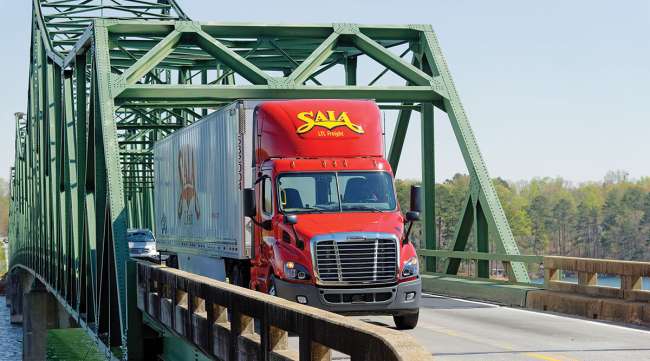Contributing Writer
Saia Sets Records for Revenue, Operating Income in Q1

[Stay on top of transportation news: Get TTNews in your inbox.]
Saia Inc. reported record operating income and revenue for the first quarter but saw business take a downturn late in the period.
The Johns Creek, Ga.-based less-than-truckload carrier said first-quarter net income rose 26.3% to $28.1 million, or $1.06 diluted earnings per share, from $22.3 million, or 85 cents, in the same period a year earlier.
Operating income hit a first-quarter record of $38.8 million, a 35.4% increase from $28.6 million in the same period a year earlier.
Revenue also hit a first-quarter record, rising 8.7% to $446.4 million from $410.6 million.

Holzgrefe
The company benefited from healthy pricing in the less-than-truckload business.
“It appears the rational approach taken by LTL carriers over the last several years continues,” CEO Fritz Holzgrefe said in an April 29 conference call with industry analysts and investors.
Saia posted multiple positive metrics during the quarter. LTL shipments per workday rose 2.3%, and tonnage per workday jumped 4%. Saia’s LTL revenue per shipment rose 4.9% to $241.61.
The carrier also won a 4.6% increase in contract renewal rates in the first quarter, down slightly from the 5.4% rate jump Saia achieved in the fourth quarter.
The first quarter remained strong into March but then the carrier saw business start to deteriorate as the recession caused by the coronavirus pandemic set in, Holzgrefe said.
On the call, Saia Chief Financial Officer Douglas Col provided data that showed how the market deteriorated as the pandemic spread. Saia’s January shipments were 8% above the same month a year earlier. The comparable figure dipped to 1.4% in February. March declined by 2.5%.
The downturn extended into April, the company said, when shipments for the month so far had plunged 17%.
Saia moved rapidly to contain expenses and furloughed about 16% of its workforce while also reducing hours across the company. It suspended performance-compensation plans and reduced executive compensation.
But at the same time, Saia added expenses to protect its workers. It awarded full-time employees an additional five days of paid time off and part-time workers one extra day so that they could take time for health issues and to care for family members. That created about $10 million of additional benefit costs for the remainder of the year.
The company also is looking to trim capital expenditures.

Much of the trucking industry relies on older onboard technology for critical functions, which can hurt reliability and efficiency. So is it time for fleets and their technology vendors to implement faster replacement cycles for onboard tech? Seth Clevenger talks to Ray Greer of Omnitracs and Deryk Powell of Velociti. Hear a snippet, above, and get the full program by going to RoadSigns.TTNews.com.
It has spent heavily on trucks recently in a bid to add safety technology and improve fuel efficiency, devoting most of the $107 million in first-quarter capital expenditures to new vehicles. But now it is deferring deliveries until later in the year.
Despite the slump, Saia continues to push its expansion into the Northeast. It opened a new terminal in the quarter near Burlington, Vt., its 19th terminal in the Northeast since launching the initiative in 2017. The company has 10 additional terminals operating this year, and they have contributed to revenue growth, Holzgrefe said.
As the economy rebounds, “I think the biggest value driver for us is clearly going to be centered around us taking advantage of the facilities that we’ve opened,” he said.
The company ended the quarter with $47 million in cash on hand and access to more than $300 million through a revolving credit facility.
Saia ranks No. 25 on the Transport Topics Top 100 list of the largest for-hire carriers in North America, and No. 9 for LTL carriers.
Want more news? Listen to today's daily briefing:




